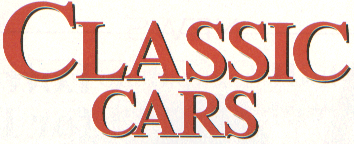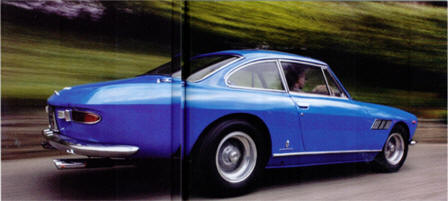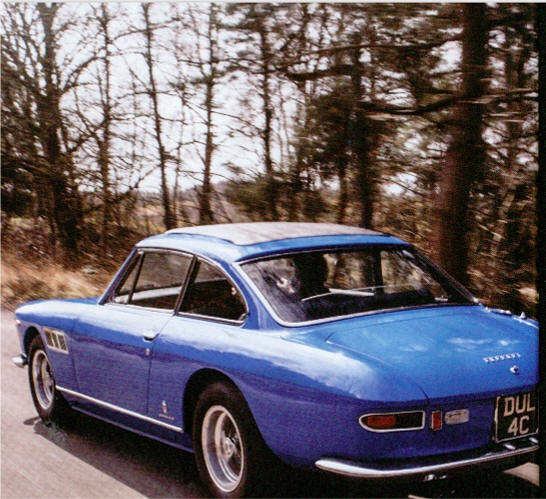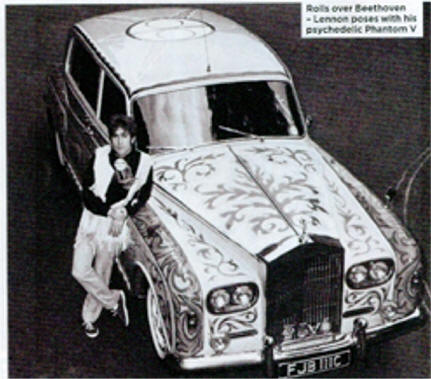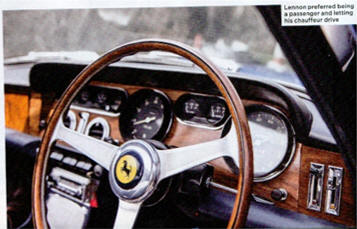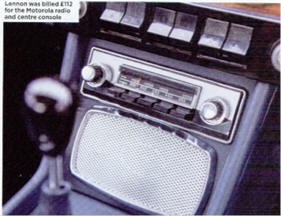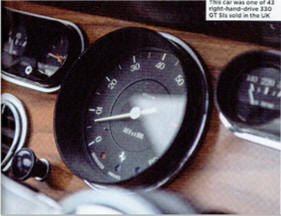 | 330 GT Registry |  |
Ticket to Ride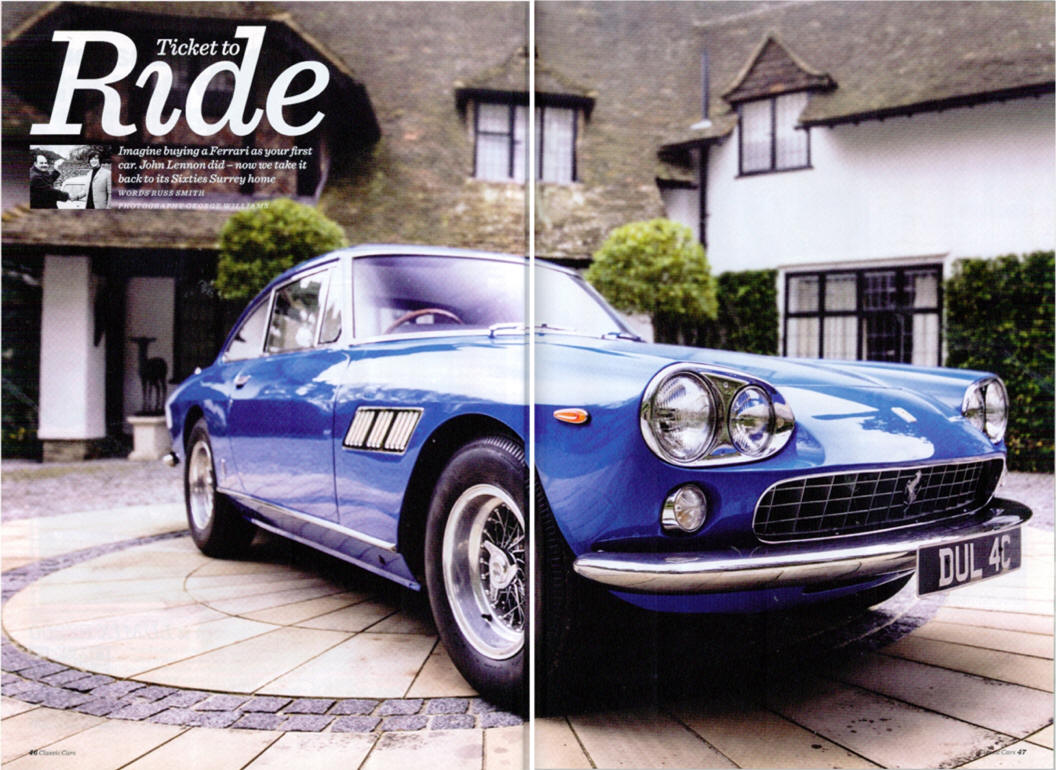
Imagine buying a Ferrari as your first
car. John Lennon did - now we take it
back to its Sixties Surrey home
WORDS RUSS SMITH
PHOTOGRAPHY GEORGE WILLIAMS
In my life, this is the winning goal at Wembley or headline act at Glastonbury moment. So it’s all downhill from here. But for now, as a lifelong Beatles fan and Italian car nut, it’s almost impossible to express the excitement I feel at the prospect of firing up John Lennon’s Ferrari 330 GT 2+2 and taking it back to the driveway of the house where he first parked it in 1965.
The cult of celebrity is nothing new. When 25-year-old Lennon passed his driving test on February 15, 1965 — before popping into the studio to record Another Girl, I Need You and Ticket to Ride - it made national news. Next morning the exotic car dealers of Surrey were camped outside his Weybridge home with their finest wares: Aston Martins, Jaguars, Maseratis, Ferraris. But it was a Ferrari 330 GT 2+2 in the unusual shade of Azzurro 20.336 that caught Lennon’s imagination, and by then money was no object for the Fab Four.
Today, we unload the car from Polygon’s transporter in the car park at Brooklands Museum and I slide into the re-upholstered blue leather seat, grinning stupidly. Give it the usual Ferrari three pumps on the throttle pedal then turn the key and... nothing. Help! Luckily, I had remembered to pack the motoring journalist’s Ferrari essentials kit: sunglasses, camera and jump leads. Hooked up to a Saab 9-5 the four-litre V12 bursts immediately and noisily into life, as it would regularly through the rest of the day when boosted by our photographer’s Mini.
With plenty of revs — I daren’t stall - the unmarked gearlever slots into reverse at the fourth attempt. It’s right and up, where fifth would be if this wasn’t a four-speed with old-school overdrive. Release the awkward upright handbrake tucked up next to the centre console and we're free of the transporter ramps.
Now we're away, slotting easily through the gears thanks to a lighter than expected and progressive clutch pedal. The driving position is perfect, the controls where you expect to find them. Add in the just-power-assisted- enough steering and this is a car almost anyone could jump in and drive quickly without fear of looking foolish —- so Lennon’s buy wasn’t as daft a step up from passing his test in an 848cc Mini as it might seem.
| ‘For me to sing Drive My Car in here just wouldn't feel right. This car’s heard the real thing’ |
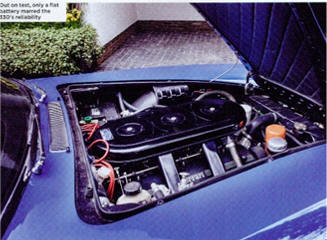
Out on test, only a flat battery marred the 330's reliability
The friendly feel of the 330 puts me in mind of the Fiat 124 Spider I used to own, most of the difference being in the V12 engine. Which figures. The 330 GT hails from the era when Enzo Ferrari famously said: ‘I sell engines. The cars I throw in for free.’
The temptation to try the original Motorola push-button radio proves too great. But hopes of finding an oldies station to add the right soundtrack are dashed by fierce static. I know pretty much every Beatles song, but keep them zipped up. For me to sing Drive My Car in here just wouldn’t feel right; this car’s heard the real thing.
Not until some months after Lennon’s decision to buy the car, however. For one thing, he was about to leave for the Bahamas to film the movie Help! Also, the Beatles’ cars were bought via Brydor Cars, a company created by their manager, Brian Epstein, to take advantage of trade discounts. Thus the 330 GT’s list price of £6521 17s 6d was reduced to the £5986 17s 6d paid by cheque from Brydor on March 16. A month later Brydor Cars billed Lennon £112 8s for fitting the radio and centre console that are still in place, then returned the car to Maranello Concessionaires to rectify a defective water pump. The Ferrari was finally delivered to Lennon at Kenwood, his home on St George’s Hill, Weybridge, in early May. And that’s where we're heading now, having been granted exclusive access.
St George’s Hill estate was once home to stars including Tom Jones and Cliff Richard, as well as Ringo Starr, whose house - Sunny Heights — was just round the corner from Lennon’s. That made it a Mecca for pop fans.
These days a stout barrier manned by handy- looking security guards secures the estate’s privacy. Despite our appointment it still comes as a relief to be allowed through into... well, into what, exactly? There’s a slightly uncomfortable otherworldliness to the estate; an over-polished and preened vision of English life seen through alien eyes. Beverley Hills done Surrey-style, if you like. So this is what money can buy you.
KENWOOD: THE HOUSE
Kenwood was designed by architect TA Allen and built in 1913 by Love & Sons.
Lennon paid £20,000 for the house on July 15, 1964, then spent twice that sum on changes, landscaping and a swimming pool.
Originally called ‘The Brown House’, it was bought by manufacturer Kenneth Wood, the man behind the Kenwood Electric Chef, who renamed the property Kenwood.
Lennon is said to have spent much of his time in the attic rooms; one was a small recording studio, another housed three Scalextric sets.
 Photographer Robert Freeman shot the cover for the Beatles’ 1965 album Rubber Soul in the garden at Kenwood.
Photographer Robert Freeman shot the cover for the Beatles’ 1965 album Rubber Soul in the garden at Kenwood. Paul McCartney wrote Hey Jude - originally called Hey Jules - on the way to Kenwood to comfort Lennon’s son Julian and wife Cynthia after he left her for Yoko Ono.
The house was sold for £40,000 in 1968 to songwriter Bill Martin.
Kenwood is now on the market with Knight Frank for £13.5 million.
Kenwood itself is protected by fancy wrought iron gates, replacing the heavy wooden sliding gate that Lennon installed to keep out fans. They swing open by remote control and close behind us as DUL4C powers up the steep, curved driveway it last departed more than 45 years ago. Now there’s areal lump in my throat; emotions I simply hadn’t prepared for.
Stopping the Ferrari on the paved circle outside the front door, I climb out and am immediately struck by how perfectly at home the car looks. Then someone else voices that very thought. Thank goodness, I’m not the only one making daft but somehow tangible attributions to inanimate objects. Animate ones too, for Kenwood is a place charged with cultural history - a backdrop to the drug-fuelled creativity of the Beatles’ middle years, where they and others would hang out, write songs, party, and be themselves in valuable moments away from the public gaze. It was also where Lennon assembled his eclectic car collection.
Few attribute great beauty to the 330 GT 2+2, especially in Series I twin-headlamp form, and it remains the least expensive of the Enzo-era Ferraris. But right here, right now, the sun lighting up its original shade of blue, it looks stunning - as it did when sold in the mid-Sixties as a premium Ferrari product, costing 10 per cent more than a 275 GTB.
Pininfarina had to make styling compromises to create a true GT with room for luggage and four proper seats, but the whole hangs together well. And those rear seats must have been a deciding factor in Lennon’s choice of the 330 GT; even after passing his test he preferred being driven to being at the wheel, so he employed a full-time chauffeur — not least because he was said to have been a terrible driver, dogged by poor eyesight and a propensity for hitting things.
Whoever was at the wheel, DUL 4C racked up 20,470 miles in Lennon’s stewardship. That’s quite some total in two and a half years, especially considering the rest of the cars he acquired during that time. The Ferrari was certainly getting plenty of exercise, but — as George Harrison later wrote - all things must pass. It should come as no surprise; 1967 was a turbulent and pivotal year in Beatles history: the highs and lows of Sgt Pepper’s Lonely Hearts Club Band and Magical Mystery Tour, Brian Epstein’s death, the global All You Need is Love broadcast, and the growing influence on Lennon of various drugs and Yoko Ono.
The Beatles had reached and passed their creative peak, and against that background you can almost understand how the delights of Ferrari ownership no longer carried any weight. In December 1967, just after Lennon was billed for a full service, the car was sold to an as-yet-unidentified second owner.
After several hours of photographing the car in every possible location on the property, our time at Kenwood is up too. Once again she’s leaving home, perhaps this time for good.
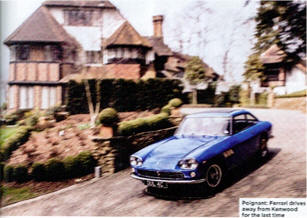
Poignant: Ferrari drives away from Kenwood for the last time
We head out of Weybridge to the quieter roads around Chobham to open the car up a bit, the bond between man and machine progressively getting better as speeds rise and bends and roundabouts are dismissed with the flick of a wrist.
With the spirit of a true GT, the 330 is one of those cars you want to drive all day, hungry for the next chance to overtake: 300bhp is still enough to make you feel imperious, and that V12 loves to rev. You blip the throttle at every opportunity, just to hear the soul-stirring, melodic tones of one of Enzo’s greatest hits. The only blot on the driving copybook is a piece of carpeted trim above the clutch pedal that keeps catching the toe of my shoe. I’ve since found reference to this in a period 330 GT road test, but solved the problem on the day by pulling off my left shoe and tossing it on the back seat. That does the trick and confirms how nice the clutch action is. | 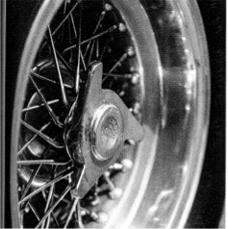 ‘You blip the throttle at every opportunity, just to hear the soul-stirring tones of one of Enzo’s greatest hits’ ‘You blip the throttle at every opportunity, just to hear the soul-stirring tones of one of Enzo’s greatest hits’ |
| ‘The 330 is one of those cars you can drive all day long, hungry for the next chance to overtake’
|
| WATCHING THE WHEELS - LENNON’S MOTORS Though the Ferrari was Lennnon’s first car, it wasn't the first he bought. That was a white Mini for his wife Cynthia when she passed her driving test in late 1964. The 330 GT did, however, trigger a bit of a car buying spree. In June ’65 he bought the black Rolls-Royce Phantom V that was used extensively as transport and became Lennon’s most famous car when given a psychedelic paint job by artist Steve Weaver in 1967. Sold for $2.3 million (about £2 million) at auction in 1985, the car is not in the royal British Columbia Museum collection in Canada. Next up, in August was a blue Mercedes 230 SL. Still wearing its original GGP 196C UK numberplates and with just 19,000 miles on the clock, also currently for sale, asking price $495k (about £330k), with a classic car dealer in Sarasota, Florida. Better known is the black Radford Mini Cooper S bought in February 1966, regularly seen and photographed around London with a chauffeur behind the wheel. Long thought to have been scrapped, the car appears to have resurfaced recently in Dublin. Other exotics included a gold Porsche 911 allegedly bought for Cynthia but which Lennon was photographed driving, and an Iso Fidia, the second built. Contrary to popular belief - including a misleading plaque displayed with the car in VW's Wolfsburg museum - Lennon never did own the white Beetle (LMW 281F) that appears on the Abben Road album cover. |
|
Many have tried to fill the gap, but so far nothing is known about what happened to the car post-Lennon until it turned up at Ferrari specialists Modena Engineering in the late Eighties, painted resale red, wearing the registration FJF 186C, showing around 80,000 miles, and fit for little more than donor status. The word is that only after the company was sold in 1989 did a check of its records show chassis number 6781 to have been the Ferrari sold to John Lennon. That simple fact saved the car. In the early Nineties the very best 330 GT was worth no more than £45,000, making restoration uneconomical. But a 330 GT that had been a Beatle’s first car was a valuable piece of history, even if it was a basket case.
So Modena’s new owners funded the rebuild, which took place between 1995 and ’97. Photos — too poor to reproduce here — show the car stripped of its floor, sills, door skins and more. Just putting the body right generated a near-£19,000 bill from Mototechnique; and seemingly endless invoices from Maranello Concessionaires for incidental parts totted up to more than £17,000. Nothing was missed in the quest to make the car like it was 1965 again, from a new £964 wiring loom to a £4354 engine rebuild by Andy Chesman Engineering. With little more than running-in mileage since, it’s no surprise that this car drives so well. The job was properly completed in April | 1998 when, with the aid of the Ferrari Owners’ Club, Lennon’s Ferrari was reunited with its original DUL4C number plate by the DVLA.
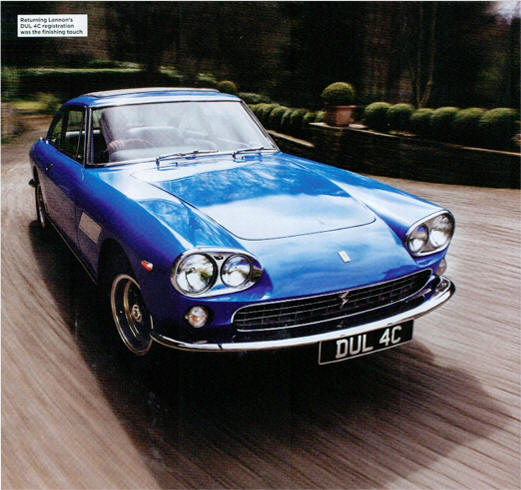
Returning Lennon's DUL 4C registration was the finishing touch
You have to say the investment in the car was worthwhile. Even without the Beatles connection, a 330 GT like this is now worth £100k. Bonhams has placed an estimate of £180-220k on Lennon’s, which may prove to be on the light side. After all, a custom-built Vox guitar of challenging appearance, seen briefly in Lennon’s hands in the I Am The Walrus video then given to a friend, has just been sold in New York for £269k.
We’ve been digging like a pack of terriers on Watership Down to find a photo of Lennon with the Ferrari, but none seems to exist. If that’s true, it must go down as a missed PR opportunity by Ferrari’s importer on almost the same scale as the record company executive who failed to sign the Beatles.
Battery aside, nothing fails during our day in the life of Lennon’s Ferrari, and the end comes too soon. Never before have I felt so reluctant to hand back a set of keys, and not just because of this particular car’s history - I’m also completely converted to the delights of the 330 GT. The model is on record as being Enzo’s personal favourite, so I shouldn’t be too surprised that this is probably the nicest Ferrari I’ve ever driven.
Thanks to: Bonhams, who will auction the car at its Goodwood Festival sale on July 12; Tim Garbett from estate agents Knight Frank; Kieron from rockstarscars.co.uk; Polygon Transport; Brooklands Museum.
FERRARI 330 GT 2+2 DEVELOPMENT
Replacing Ferrari’s first four-seater, the 250 GTE 2+2,the 330 GT was launched in January 1964. Purists again cried foul, but the 2+2 again outsold all other Ferrari models, becoming the first Ferrari to sell | more than 1000 units. Though based on the 250 GTE’s chassis, there were many improvements, including another 65bhp from a one-litre increase in engine capacity - a stretch that meant increasing the V12’s bore spacings. Spark plugs were repositioned, an alternator made a welcome debut and the chassis was stretched by 50mm to increase room in the back. Better Dunlop disc brakes and adjustable Koni dampers completed the mechanical upgrades. The Pininfarina design wasn’t to everyone’s taste, with the slant-eyed twin headlamps proving too radical for some. During 1965, after 500 SIs had been built, Ferrari introduced single headlamps on the SII. The SIl also gained bumper over-riders, alloy wheels (with Borrani wires now only an option), and a five-speed gearbox in place of the old four-speed plus overdrive unit. The more conservatively styled headlamps improved sales, with 575 SIIs built before the 330 GT was replaced by the 365 GT 2+2 in late 1967 - though UK sales were 43 right- hand drive SIs, but only 35 SIIs.

2+2 chassis grew by 50mm to create space for proper rear seats
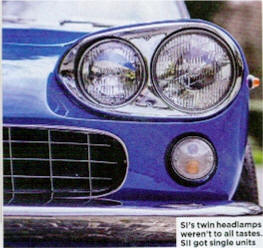
SI’s twin headlamps weren’t to all tastes. SII got single units
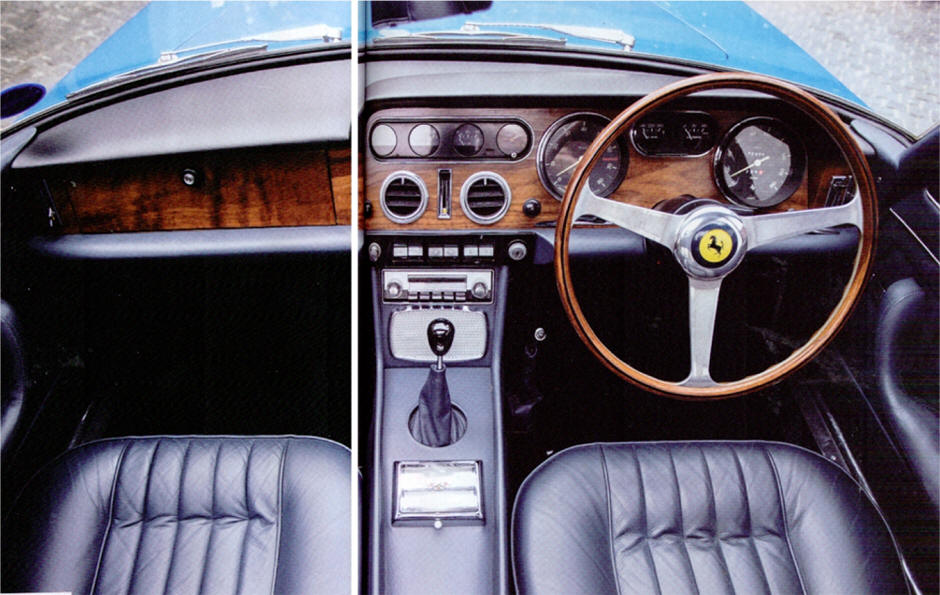
This is a place you could love being in for eight days a week
Lennon preferred being a passenger |
Lennon was billed £112 for the Motorola radio and centre console |
This car was one of 45 right-hand-drive 330 GT SIs sold in the UK |
1965 Ferrari 330 GT 2+2
* Engine 3967cc, V12, ohc per bank, three Weber 40DCZ/6 carburettors * Power and torque 300bhp @ 6600rpm; 288lb ft @ 5000rpm * Transmission Four-speed manual, overdrive on top gear, rear-wheel drive, limited-slip differential Steering Worm-and-peg ° Suspension Front: independent, wishbones, coil springs, anti-roll bar, telescopic dampers. Rear: live axle, semi-elliptic leaf springs, radius rods, telescopic dampers with helper coils * Brakes Discs front and rear, dual servo-assistance + Weight 1420kg (3180lb) * Performance Top speed 144mph; 0-60mph 7.1sec * Fuel consumption 14-16mpg + Cost new £5986 « Estimate now £180,000-220,000 (including ‘Lennon factor’)
August 2013 CLASSIC CARS
© Bauer Automotive 20013
